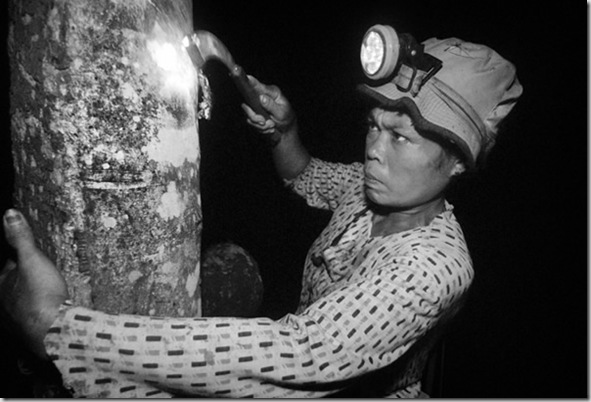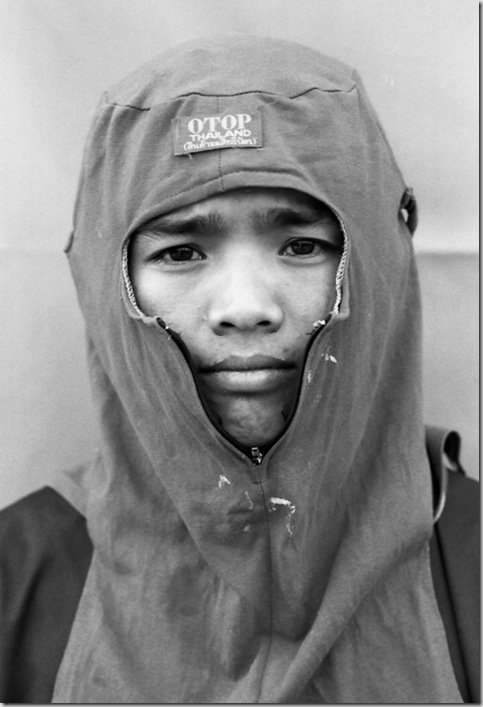Documentary Project by John Hulme

But the free movement of finance capital stands in stark contrast to the plight of the millions of legal and “illegal” migrants throughout the world who are confronted by a myriad of border controls, racist legislation and other measures blocking their efforts to escape poverty, famine, political repression or war.

The following photographs reveal something of the problems and difficulties confronting Burmese migrant workers in Thailand—fishermen in the south-west; factory workers, and day labourers, hundreds of whom cross the Moie River on rubber inner tubes each day.

These scenes, of course, are not peculiar to Asia but are repeated in a variety of forms throughout the world—in Europe, Australia, the Americas and elsewhere—with tragic consequences.

In Thailand there are an estimated two and a half million migrants from Burma (now known as Myanmar) who have entered the country since the mid-1980s in search of a job—any job—and the hope of a better life for their families.

Thai Immigration regularly conduct sweeps or raids on construction sites rounding up all workers registered or not and put them in jail, if they want to get back quickly to their families and work then they are encouraged to pay a “Fine”.

Even though they are paid less than the minimum wage and have little freedom in Thailand it is still more than they would earn in Burma, and with a good employer life can be better than in Burma where forced labour extortionate taxes and land confiscation are common.

But life in Thailand for Burmese migrants brings new difficulties. More than half of these mainly young workers are undocumented, forced to eke out a living on rock-bottom wages and in constant fear of deportation. They are employed in dirty, dangerous and difficult jobs in Thailand’s fishing and construction industries, rubber plantations, dockyards and shrimp farms, as well as providing cheap labour for the tourist industry. Migrants without passports, official papers or sponsored jobs have to rely on labor agents, or “carrys” as they are known, who promise well-paid employment and the opportunity to send small amounts of money back home to help their families. In Burma “carrys” demand between £250 and £400 to take migrants through military and police checkpoints on both sides of the border.

Securing a work permit is difficult, time consuming and expensive, costing over £100, more than a month’s wages. And the process is complicated because the rules can change from one year to the next. Those without a work permit are deemed “illegal”, forced to take on low-paid, unsafe work and at the mercy of ruthless bosses and corrupt government officials and police. Arrest, extortion, deportation and sexual abuse are common place.
It’s my hope that some of these difficulties and tragedies facing Burmese migrants in Thailand—a microcosm of the conditions of life facing millions of migrant workers around the world—can be found in these photographs”.
All images © JOHN HULME
About the Photographer
John Hulme is a documentary photographer dividing his time between South East Asia and Britain. His work has focused on documenting social issues in Europe, Thailand, Burma and India.
John’s work has been published in books, Magazines and newspapers, including AOL, Pacific Press (Japan), MacMillan Education, Heinemann, BBC, McGraw Hill (US), Longman Asia, Oxford University Press, Cambridge University Press, MacMillan Oxford, Independent On Sunday, Evans Brothers, Aladdin Books, APA Publications (Singapore), Dorling Kindersley, Financial Times and The Sydney Morning Herald.
As an accredited photographer for the BBC and Channel Four he has been involved in the production of several documentary’s, most recently for Panorama shooting Hi-8 footage of Thailand’s Chicken farms and slaughter houses.
John was invited by Kent University, Canterbury (UK) to exhibit his work. The exhibition “Burma’s Forgotten War” Images from the Thai/Burma border depicting Karen insurgents, Refugee camps and backpack medic’s, was well received, informing both students and academics about a part of the world that receives little if any, media attention.
Recent work includes the documentation of Burmese Migrant Workers, the Karen people of Burma, including their military wing, the Karen National Liberation Army (KNLA). Gold Mining in Kachin state Upper Burma. And the 2010 Khumbh Mela in Haridwar India, the largest gathering of humanity on the planet.
His essay on Burmese migrant workers titled “In Search of a Job-any Job” has been widely shown including at the Foreign Correspondents club of Thailand, the Art’s centre Chiang Mai, at Oxford University’s Refugee Studies Centre, also last summer at New York’s Exit Art Gallery during their multi-media exhibition “Contemporary Slavery”.
John currently lives in Chiang Mai Northern Thailand.
Fonte































Nessun commento:
Posta un commento